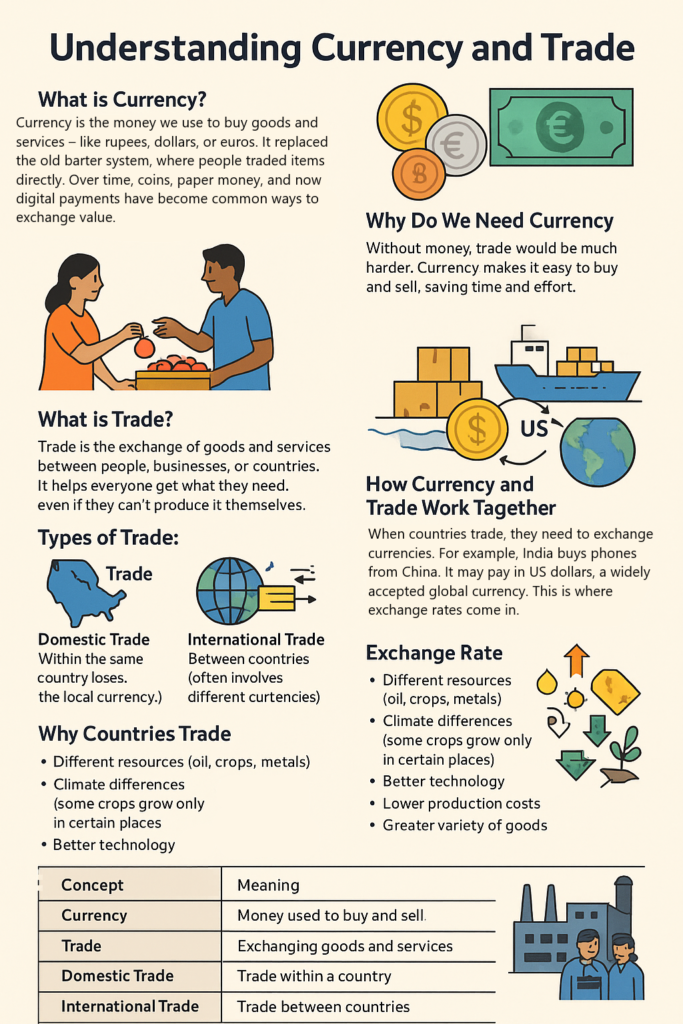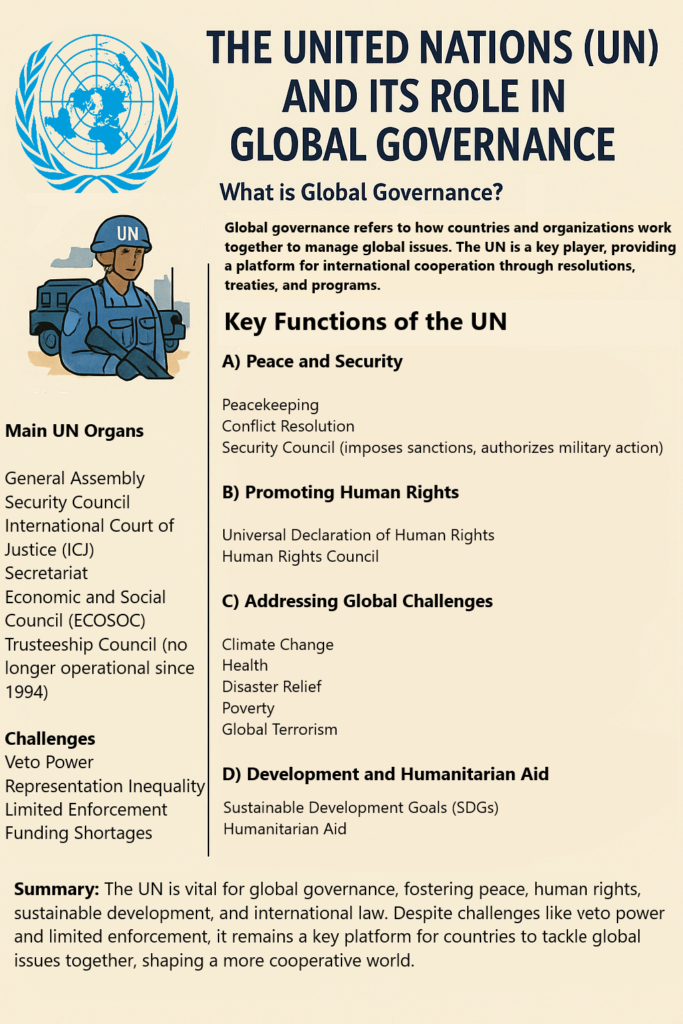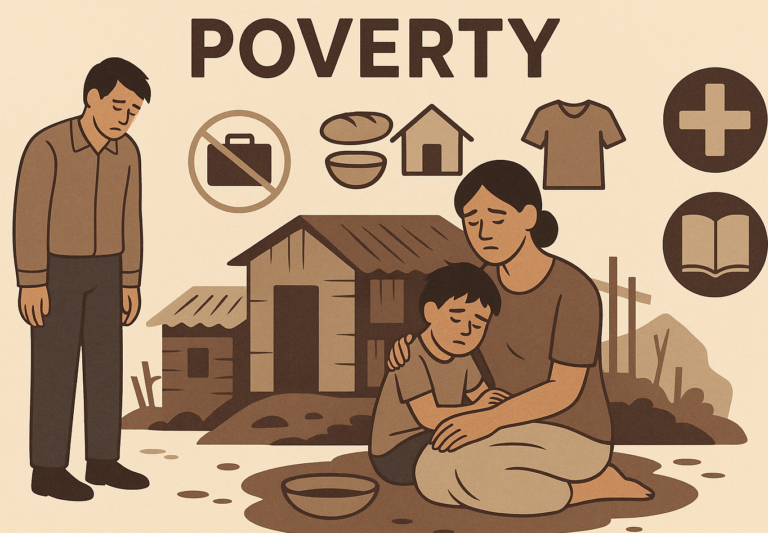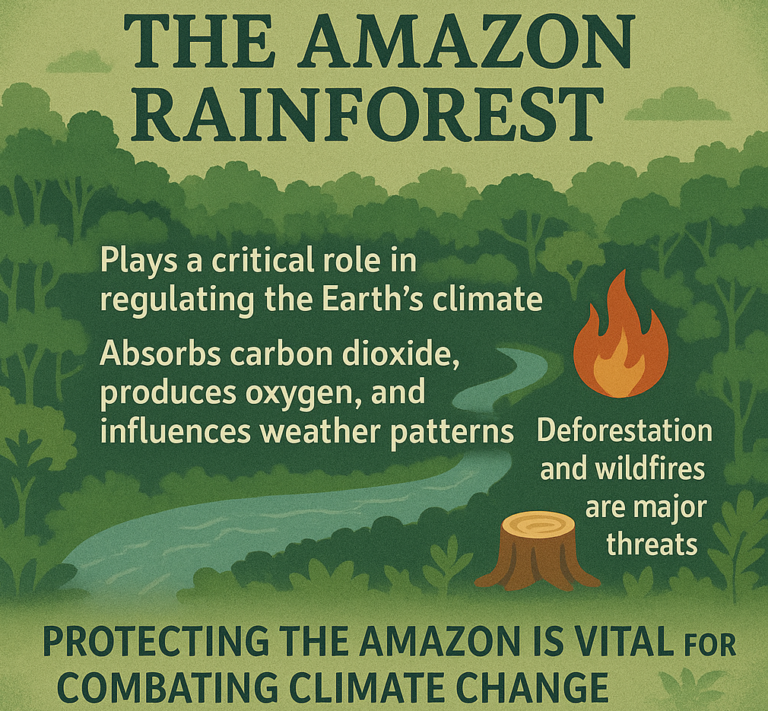Currency is a medium of exchange used to buy and sell goods and services. In simpler words, it’s the money we use in our everyday lives — whether it’s to buy a loaf of bread, pay for a haircut, or purchase a mobile phone. Without currency, we would have to exchange things directly, like in the old days when people used the barter system.

From Barter to Currency
Before money existed, people followed the barter system, where they exchanged goods directly. For example, if a farmer had wheat and needed milk, he would exchange his wheat with a person who had cows. The problem with this system was that both people had to want what the other had — this is called a “double coincidence of wants.” It wasn’t always easy.
To solve this, people slowly started using things like salt, shells, gold, and silver as early forms of money. Over time, this led to the development of coins, then paper money, and now we even use digital currency like credit cards, online payments, and mobile wallets.
Types of Currency Today
Every country has its own official currency. Here are a few examples:
- United States – Dollar (USD)
- India – Rupee (INR)
- Japan – Yen (JPY)
- United Kingdom – Pound Sterling (GBP)
- European Union – Euro (EUR)
Each currency is issued and controlled by the country’s central bank, such as the Reserve Bank of India (RBI) or the Federal Reserve in the USA.
What is Trade?
Trade is the process of buying, selling, or exchanging goods and services. It can happen between individuals, companies, or entire countries. Trade helps everyone get the products or resources they need, even if they can’t produce them themselves.
Imagine a country that has lots of land and farms — it can grow plenty of food. Another country may be rich in oil but can’t grow much food. Trade allows both countries to exchange their extra resources for the things they need.
Types of Trade
There are two main types of trade:
- Domestic Trade
- This is trade that happens within the same country.
- For example, a farmer in Punjab selling wheat to a bakery in Delhi.
- The transaction is done in the same currency (like Indian Rupees in India).
- International Trade
- This is trade that happens between countries.
- For example, India buying crude oil from Saudi Arabia, or exporting spices to the UK.
- In this case, different currencies are involved, and often the payment is made in a widely accepted currency like the US Dollar.
How Currency and Trade Work Together
When countries trade, they usually don’t use the same currency. Let’s say India wants to import mobile phones from China. China uses the Yuan, and India uses the Rupee. China doesn’t want to be paid in Rupees because it’s not useful in their country. So, India must convert Rupees into Yuan, or more commonly, US Dollars, which are accepted worldwide for trade.
This brings us to a very important concept in international trade: the foreign exchange market, or Forex. This is where currencies are bought and sold, and where exchange rates are decided.
What is an Exchange Rate?
An exchange rate is the value of one currency compared to another. It tells you how much of one currency you need to buy another.
Example:
- 1 US Dollar = 83 Indian Rupees
This means if you have 1 dollar, you can exchange it for 83 rupees.
But this rate changes every day depending on economic factors like demand, supply, inflation, and interest rates.
When businesses or governments trade internationally, they must pay attention to these exchange rates, because a change in the rate can increase or decrease the cost of importing and exporting.
Why Do Countries Trade?
No country can produce everything it needs. Some have natural resources, while others are rich in technology, labor, or skills. Trade allows countries to specialize in what they do best and import what they can’t make efficiently.
Reasons Countries Trade:
- Resource Availability – Some countries have oil, some have metals, others have farmland.
- Climate – Certain crops only grow in specific climates (e.g., coffee, bananas).
- Technology and Expertise – Countries like Japan and Germany are known for advanced technology.
- Cost Efficiency – It may be cheaper to buy something from another country than to make it yourself.
- Variety – Trade allows people to enjoy products from all over the world.
Imports and Exports
In trade, we often use two key terms:
- Import – When a country buys goods from another country.
- Example: India imports electronics from China.
- Export – When a country sells goods to another country.
- Example: India exports tea and spices to the UK.
A healthy balance of imports and exports is good for the economy. Countries aim to export more than they import to earn foreign currency and strengthen their economy.
How Trade Affects the Economy
Trade plays a huge role in a country’s economic growth. Here’s how:
- Creates Jobs – More production means more employment.
- Boosts GDP – More trade increases the country’s total income.
- Improves Quality of Life – Access to a variety of goods and services.
- Strengthens International Relations – Trade builds partnerships between countries.
However, trade can also lead to problems like:
- Trade Deficit – When imports are much higher than exports.
- Unfair Competition – Local industries may suffer if foreign goods are cheaper.
- Economic Dependence – Relying too much on other countries for essentials.
Summary
| Concept | Description |
|---|---|
| Currency | Money used in a country for buying and selling goods or services. |
| Trade | The exchange of goods and services between individuals, businesses, or nations. |
| Domestic Trade | Trade within the same country, using the national currency. |
| International Trade | Trade between different countries, often involving currency exchange. |
| Exchange Rate | The value of one currency in terms of another. |
| Imports | Goods or services a country buys from abroad. |
| Exports | Goods or services a country sells to other countries. |
Trade and currency are two of the most important pillars of the modern global economy. Understanding how they work helps us see how countries are connected, how economies grow, and how people around the world get the things they need every day.











